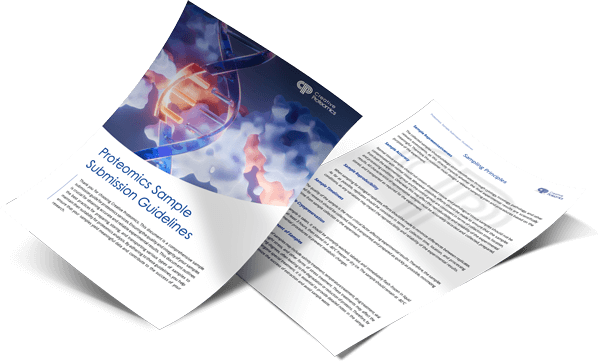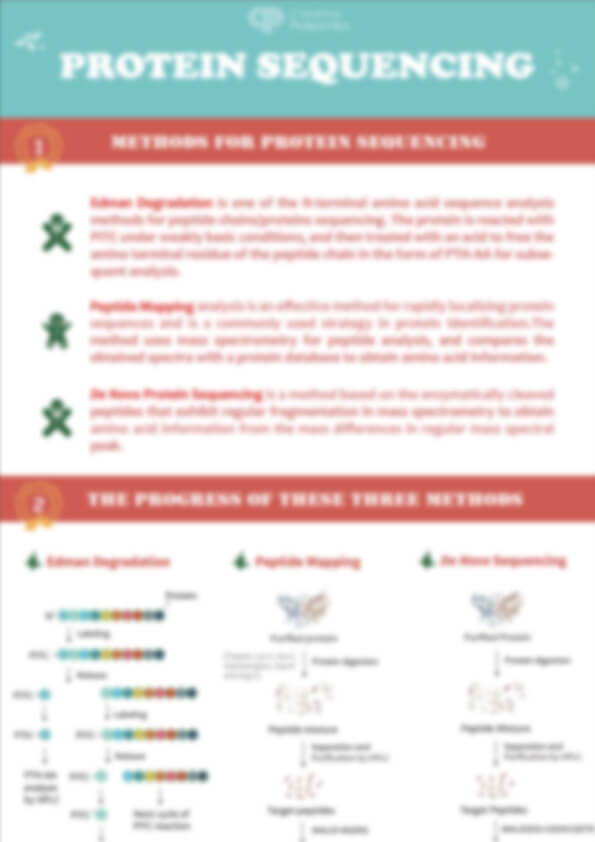Protein Sequencing by Mass Spectrometry
Creative Proteomics' mass spectrometry protein sequencing service provides 100% sequence coverage, accurate protein identification and advanced PTM analysis. In addition, we offer other protein sequencing solutions: Edman protein sequencing, nanopore protein sequencing and single molecule fluorescence sequencing.
Submit Your Request Now
×- Protein Mass Spectrometry
- How It Works
- Protein MS Serives We Provide
- Applications
- Sample Requirements
- FAQ
- Demo
- Case & Pulication
What is Protein Mass Spectrometry?
Protein mass spectrometry is a powerful analytical technique used to study and characterize proteins in various dimensions, such as identification, quantification, structural analysis, and post-translational modification (PTM) mapping. Protein mass spectrometry includes methods like top-down, middle-down, and bottom-up proteomics, which differ in how the protein is processed before analysis. These methods provide insights into primary protein structures, PTMs such as glycosylation, and protein interactions.
 Three approaches of mass spectrometry-based proteomics.(Eric Adua,J Hum Hypertens,2023)
Three approaches of mass spectrometry-based proteomics.(Eric Adua,J Hum Hypertens,2023)
How Dose Protein Mass Spectrometry Work?
Technical Platforms
Creative Proteomics provides mass spectrometry-based protein sequence analysis using the high-resolution Obitrap Fusion Lumos mass spectrometer.
 Orbitrap Fusion Lumos Mass Spectrometer (Picture come from the official website)
Orbitrap Fusion Lumos Mass Spectrometer (Picture come from the official website)
Our platform ensures 100% sequence coverage, high sensitivity for low-abundance peptides, and combines HCD and ETD fragmentation for accurate N-terminal, C-terminal, and full-length protein sequencing, including de novo sequencing for unknown samples.
Workflow of mass spectrometry sequencing

The sequence analysis process of protein samples will generally only use Trypsin for protein digestion, and the coverage of identified peptides is about 60%. In order to obtain the full sequence information of the target proteins, we use six proteases (Trypsin, Chymotrypsin, Asp-N, Glu-C, Lys-C and Lys-N) commonly used in protein sequence analysis to perform enzymatic cleavage and mass spectrometry on the target proteins to complete the determination of 100% of the protein sequence.
Protein Mass Spectrometry Sequencing Advantages
Protein mass spectrometry sequencing offers several significant advantages in the field of proteomics and biological research:
- Identification and Characterization of Proteins: Mass spectrometry (MS) enables comprehensive identification and characterization of proteins, even those present in low abundance or undergoing PTMs.
- Quantification and Functional Analysis: In addition to protein identification, MS allows for the quantification of proteins in different samples, making it valuable for studying protein abundance changes under various conditions.
- Comprehensive Protein Profiling: MS can analyze complex protein mixtures without the need for prior knowledge of the protein species. Techniques like LC-MS allow for the analysis of complex biological samples, providing a broad profile of the proteome.
- Speed and Throughput: Advanced mass spectrometry technologies offer significantly higher speed and throughput compared to traditional methods like Edman degradation and NMR spectroscopy. This enables the rapid identification of blocked or modified proteins and PTMs in large-scale biological studies while overcoming the limitations of traditional techniques, such as difficulties with larger or membrane-bound proteins, providing more accurate and scalable results.
Protein Mass Spectrometry Service at Creative Proteomics
The following mass spectrometry-based sequence analysis services are available:
De Novo Peptides/Proteins Sequencing Service
This approach is essential for identifying novel peptides, proteins from unsequenced organisms, or uncharacterized antibodies, which cannot be detected using traditional database search methods.
This process determines the amino acid sequence of antibodies and identifies any post-translational modifications, without relying on prior DNA or protein sequences.
Sequence Analysis of Peptides or Proteins
We offer a comprehensive range of protein sequence analysis services, including N-terminal and C-terminal sequencing, full protein sequence analysis, and de novo sequencing.These services use advanced techniques such as LC-MS to determine the amino acid sequence of proteins, which is essential for understanding their structure, function, and interactions.
Top down based protein sequencing
This method provides valuable insights into both N- and C-terminal sequences, even in the presence of modifications such as acetylation or pyroglutamic acid.
Full protein sequence determination
Protein sequencing aims to reveal the complete amino acid sequence of a protein, going beyond just examining its N- or C-termini.
Appliacations of Protein Mass Spectrometry
Protein Identification and Structural Analysis:
MS is extensively used for identifying proteins and determining their structure. It can provide detailed information on protein sequences, folding, and interactions through techniques like peptide mass fingerprinting, de novo sequencing, and tandem mass spectrometry.
Protein Quantification:
MS enables the quantification of proteins in biological samples, both in terms of relative abundance and absolute quantification.
Post-Translational Modifications Analysis:
MS is a powerful tool for identifying and mapping PTMs such as phosphorylation, glycosylation, acetylation, and methylation. PTM analysis via MS is particularly useful for characterizing signaling pathways, biomarker discovery, and drug development.
Biomarker Discovery of Disease:
Protein mass spectrometry plays a key role in identifying biomarkers for diseases, including cancer, metabolic disorders, and neurodegenerative diseases.
Drug Discovery and Development:
In drug discovery, MS helps identify drug candidates, study their binding affinity to target proteins, and investigate their metabolism and pharmacokinetics.
Protein Interaction Studies:
MS is used to study protein-protein interactions, crucial for understanding cellular processes and signaling pathways.
Antibody Discovery and Reagent Validation:
In immunology, MS is used to discover and characterize antibodies, especially those with therapeutic potential. MS facilitates de novo sequencing of antibody variants and the identification of neutralizing antibodies.
Our Advantages
- Complete Protein Sequencing:Using the Orbitrap Fusion Lumos, Creative Proteomics achieves 100% sequence coverage, ensuring precise protein identification and de novo sequencing for unknown proteins.
- Accurate Protein Quantification:Our advanced mass spectrometry enables both relative and absolute quantification, providing high sensitivity for low-abundance proteins in complex samples.
- Comprehensive PTM Analysis: We specialize in phosphorylation, glycosylation, and other post-translational modifications, key for understanding signaling pathways and disease mechanisms.
- Broad Applications & Bioinformatics Support: Our services cover protein identification, protein interactions, and biomarker discovery, with strong bioinformatics support for data analysis and pathway mapping.
Sample Requirements
| Sample type | Recommended sample size | |
|---|---|---|
| Animal tissues | Hard tissues (bones, hair) | 300-500mg |
| Soft tissues (leaves, flowers of woody plants, herbaceous plants, algae, ferns) | 200mg | |
| Plant tissues | Hard tissues (roots, bark, branches, seeds, etc.) | 3-5g |
| Microbes | Common bacteria, fungal cells (cell pellets) | 100μL |
| cells | Suspension/adherent cultured cells (cell count/pellet) | >1*107 |
| Fluids | Plasma/serum/cerebrospinal fluid (without depletion of high abundance proteins) | 20μL |
| Plasma/serum/cerebrospinal fluid (with depletion of high abundance proteins) | 100μL | |
| Follicular fluid | 200μL | |
| Lymph, synovial fluid, puncture fluid, ascites | 5mL | |
| Others | Saliva/tears/milk | 3-5mL |
| Culture supernatant (serum-free medium cannot be used) | 20mL | |
| Pure protein (best buffer is 8MUrea) | 300μg | |
| FFPE | Each slice: 10µm thickness, 1.5×2cm area | 15-20 slices |
Protein Mass Spectrometry FAQs
How is protein sequence analysis performed?
Protein sequence analysis is performed by extracting proteins from biological samples, digesting them into peptides using proteases, and analyzing these peptides through mass spectrometry. The peptides are ionized, fragmented, and the resulting spectra are used to identify and sequence the amino acids. This process can be complemented by database searching or de novo sequencing to determine the full protein sequence.
What is full-length protein sequencing, and how is it achieved?
Full-length protein sequencing refers to determining the entire amino acid sequence of a protein. This is achieved by digesting proteins into smaller peptides, employing advanced mass spectrometry techniques to analyze the peptides, and reconstructing the full sequence from the resulting data. Full-length sequencing may also use top-down proteomics, which analyzes intact proteins directly.
What is the difference between top-down and bottom-up proteomics?
Top-down proteomics analyzes intact proteins without prior digestion, maintaining their full molecular weight, whereas bottom-up proteomics involves digesting proteins into peptides before analysis. Top-down proteomics allows the study of protein isoforms and modifications, while bottom-up provides easier analysis of smaller peptides and is more widely used for protein identification.
What bioinformatic analysis of proteomic results is generally required?
Bioinformatic analysis of proteomic results includes comparing experimental data to protein databases for identification, quantifying protein levels, identifying PTMs, normalizing data, and applying statistical tests. It also involves mapping proteins to biological pathways, predicting protein interactions, and modeling protein structures, all aimed at interpreting the biological significance of the proteomic data.
Learn about other Q&A about other technologies.
Demo for Protein Mass Spectrometry Service
Figures come from (Shibata, H.et.al, J Clin Immunol,2024)
Protein Mass Spectrometry Case study
Publications
Here are some publications from our clients:

- Isolation of the mustard Napin protein Allergen Sin a 1 and characterisation of its antifungal activity. 2022. https://doi.org/10.1016/j.bbrep.2022.101208
- Functional Characterization of Propeptides in Plant Subtilases as Intramolecular Chaperones and Inhibitors of the Mature Protease. 2016. https://doi.org/10.1074/jbc.M116.744151
- Chemoproteomic identification of CO2-dependent lysine carboxylation in proteins. 2022. https://doi.org/10.1038/s41589-022-01043-1




















